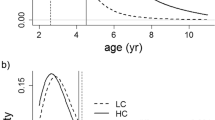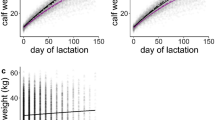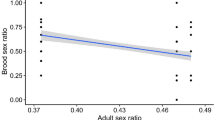Abstract
That female vertebrates who are able to invest more than average in their offspring should produce male-biased sex ratios was first suggested by Trivers and Willard1 who reasoned that the breeding success of males is more variable than that of females and so may be more strongly influenced by parental investment. Their evidence for a positive association between maternal condition and birth sex ratios was unconvincing2,3 and no subsequent studies have produced conclusive evidence supporting their hypothesis4,8. We show here that, in polygynous red deer (Cervus elaphus), dominant mothers produce significantly more sons than subordinates and that maternal rank has a greater effect on the breeding success of males than females.
This is a preview of subscription content, access via your institution
Access options
Subscribe to this journal
Receive 51 print issues and online access
$199.00 per year
only $3.90 per issue
Buy this article
- Purchase on Springer Link
- Instant access to full article PDF
Prices may be subject to local taxes which are calculated during checkout
Similar content being viewed by others
References
Trivers, R. L. & Willard, D. E. Science 179, 90–92 (1973).
Myers, J. H. Am. Nat. 112, 381–388 (1978).
Williams, G. C. Proc. R. Soc. B205, 567–580 (1979).
Clutton-Brock, T. H. Nature 298, 11–13 (1982).
Clutton-Brock, T. H. & Albon, S. D. in Current Problems in Sociobiology (ed. King's College Sociobiology Group) (Cambridge University Press, 1982).
Altmann, J. Baboon Mothers and Infants (Harvard University Press, Cambridge, 1980).
Simpson, M. J. & Simpson, A. E. Nature 300, 440–441 (1982).
Silk, J. B. Am. Nat. 121, 56–66 (1983).
Clutton-Brock, T. H., Guinness, F. E. & Albon, S. D. Red Deer: Behavior and Ecology of Two Sexes (University of Chicago Press, 1982).
Clutton-Brock, T. H., Albon, S. D., Gibson, R. M. & Guinness, F. E. Anim. Behav. 27, 211–225 (1979).
Clutton-Brock, T. H., Albon, S. D. & Guinness, F. E. Nature 300, 178–180 (1982).
Ryder, M. L. J. Zool. 181, 137–143 (1977).
Mitchell, B. & Lincoln, G. A. J. Zool. 171, 141–152 (1973).
Small, M. F. Int. J. Primatol. 2, 91–95 (1981).
Clutton-Brock, T. H., Albon, S. D. & Guinness, F. E. Nature 289, 487–487 (1981).
Clutton-Brock, T. H. in Evolution from Molecules to Men (ed. Bendall, D. S.) (Cambridge University Press, 1983).
Suttie, J. M. Anim. Behav. 31, 610–611 (1983).
Charnov, E. L. The Theory of Sex Allocation (Princeton University Press, 1982).
Verme, L. J. J. Wildl. Mgmt 33, 881–887 (1969).
Verme, L. J. & Ozoga, J. J. J. Wildl. Mgmt 45, 710–715 (1981).
McCullough, D. R. The George Reserve Deer Herd (University of Michigan Press, 1979).
Geist, V. Mountain Sheep (University of Chicago Press, 1971).
Bygott, D. thesis, Univ. Cambridge (1974).
Novikoshi, K. & Koyama, N. in Symp. of the 5th Congr. of Int. Primatological Soc. (eds Konde, S., Kawai, M., Ehara, A. & Kawamura, S.) 43–61 (Japan Science, Tokyo, 1974).
Packer, C. thesis. Univ. Sussex (1977).
Dewsbury, D. A. Q. Rev. Biol. 57, 135–159 (1982).
Kawai, M. Primates 14, 113–159 (1958).
Missakiah, E. Primates 13, 169–180 (1972).
Hausfater, G., Altmann, J. & Altmann, A. Science 217, 752–755 (1982).
Dunbar, R. I. M. Behav. Ecol. Sociobiol. 7, 253–265 (1980).
Clutton-Brock, T. H., Greenwood, P. & Powell, R. P. Z. Tierpsychol. 41, 202–216 (1976).
Kermack, K. A. & Haldane, J. B. S. Biometrika 37, 30–41 (1950).
Author information
Authors and Affiliations
Rights and permissions
About this article
Cite this article
Clutton-Brock, T., Albon, S. & Guinness, F. Maternal dominance, breeding success and birth sex ratios in red deer. Nature 308, 358–360 (1984). https://doi.org/10.1038/308358a0
Received:
Accepted:
Issue Date:
DOI: https://doi.org/10.1038/308358a0
This article is cited by
-
Male’s age and plumage coloration predicts brood sex ratio in the Common Kingfisher (Alcedo atthis)
Journal of Ornithology (2023)
-
The Trivers-Willard Effect for Educational Investment: Evidence from an African Sample
Evolutionary Psychological Science (2023)
-
Reproductive performance and sex ratio adjustment of the wild boar (Sus scrofa) in South Korea
Scientific Reports (2022)
-
Facultative and persistent offspring sex-ratio bias in relation to the social environment in cooperatively breeding red-winged fairy-wrens (Malurus elegans)
Behavioral Ecology and Sociobiology (2022)
-
Maternal lactational investment is higher for sons in chimpanzees
Behavioral Ecology and Sociobiology (2022)
Comments
By submitting a comment you agree to abide by our Terms and Community Guidelines. If you find something abusive or that does not comply with our terms or guidelines please flag it as inappropriate.



